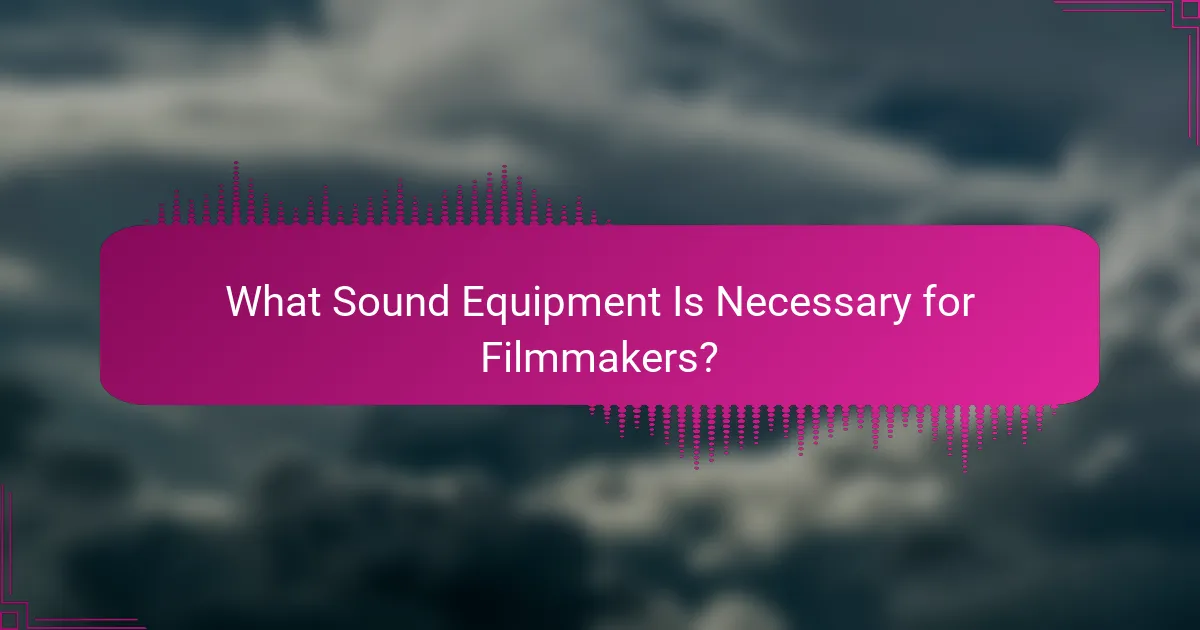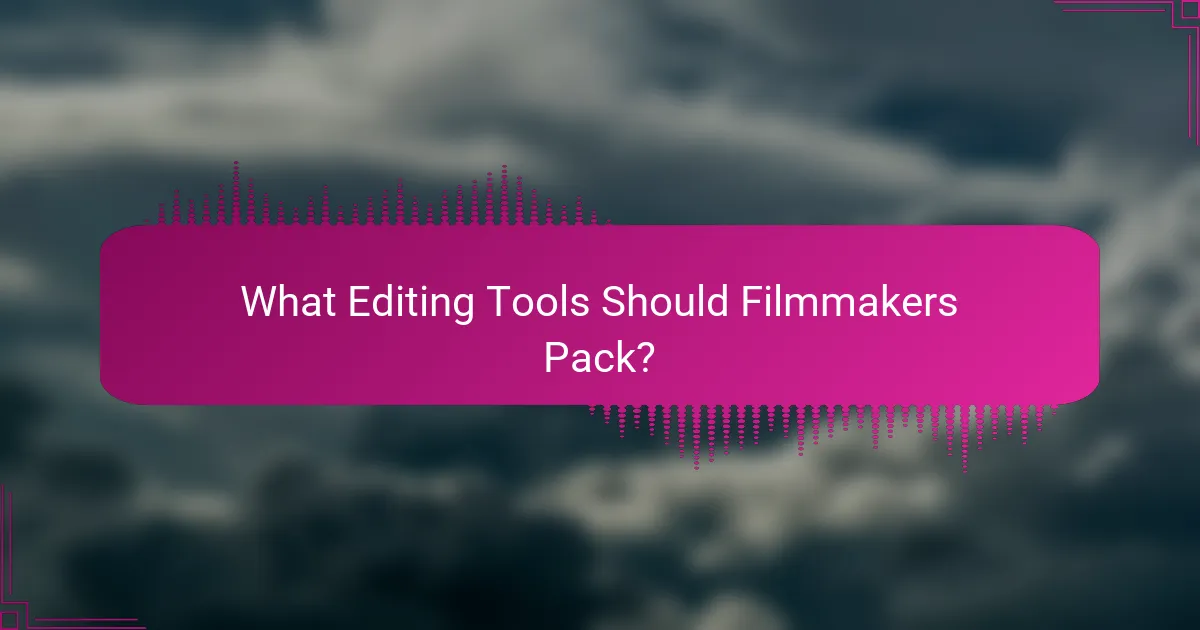Attending an indie film festival requires careful preparation, and packing the right essentials can significantly enhance your experience. From camera equipment and sound recording gear to marketing materials and comfort items, having the right tools at your disposal can elevate your production quality and networking opportunities. Prioritize items that align with your filmmaking needs to ensure a successful festival journey.

What Essential Packing Items Should Filmmakers Bring to Indie Film Festivals?
Filmmakers attending indie film festivals should prioritize packing essential items that enhance their production capabilities and networking potential. Key categories include camera equipment, sound recording gear, editing tools, marketing materials, and comfort items to ensure a smooth experience.
Camera equipment
Camera equipment is crucial for capturing high-quality footage during the festival. Bring your primary camera, lenses, and backup gear to avoid any mishaps. Consider packing a tripod, gimbal, or stabilizer to ensure steady shots, especially in dynamic environments.
Make sure to include extra batteries and memory cards, as running out of power or storage can hinder your filming process. A lightweight camera bag can help you transport your gear easily between events.
Sound recording gear
Sound quality can make or break a film, so bringing the right sound recording gear is essential. Pack a quality microphone, such as a shotgun or lavalier mic, to capture clear audio. Additionally, consider a portable audio recorder for flexibility in various settings.
Don’t forget to include headphones for monitoring sound during recordings. Having backup cables and batteries will help prevent technical issues that could disrupt your filming schedule.
Editing tools
Editing tools are vital for post-production tasks, even while at the festival. Bring a laptop with your preferred editing software installed, ensuring it meets the system requirements for smooth operation. External hard drives can provide additional storage for your footage and backups.
Consider downloading any necessary updates or plugins before the festival to avoid connectivity issues. A portable power bank can also be handy for charging devices during long days at the event.
Marketing materials
Marketing materials are essential for promoting your film and networking with industry professionals. Prepare business cards that include your contact information and social media handles. Consider creating a one-sheet or brochure that highlights your film’s key details and screening times.
Having digital versions of your marketing materials can be useful for sharing via email or social media. Be ready to engage with potential collaborators or investors, as first impressions matter in the film industry.
Comfort items
Comfort items can greatly enhance your festival experience, allowing you to focus on your film and networking. Bring comfortable shoes, as you may be on your feet for long periods attending screenings and events. A refillable water bottle and snacks can help keep your energy levels up throughout the day.
Consider packing a portable charger for your devices, ensuring you stay connected without worrying about battery life. A light jacket or sweater can also be useful for varying temperatures in venues.

How to Choose the Right Camera for Film Festivals?
Selecting the right camera for film festivals involves understanding your specific needs, budget, and the type of content you plan to create. Consider factors such as image quality, versatility, and ease of use to ensure your camera meets the demands of festival screenings.
DSLR vs. mirrorless
When choosing between DSLR and mirrorless cameras, consider their distinct advantages. DSLRs typically offer longer battery life and a wider selection of lenses, making them suitable for various shooting conditions. However, mirrorless cameras are often lighter, more compact, and provide superior video capabilities, which can be beneficial for filmmakers.
Evaluate your shooting style and preferences. If you prioritize portability and advanced video features, a mirrorless camera may be the better choice. Conversely, if you value traditional handling and lens options, a DSLR could serve you well.
Resolution and frame rate
Resolution and frame rate are crucial factors in camera selection for film festivals. Aim for at least 1080p resolution for high-quality visuals, with many filmmakers opting for 4K for enhanced detail. Frame rates typically range from 24 to 60 frames per second (fps), with 24 fps being the standard for cinematic look.
Consider your project’s requirements. For dramatic storytelling, 24 fps is ideal, while higher frame rates like 60 fps can be advantageous for action sequences or slow-motion shots. Ensure your camera can handle the desired resolution and frame rate without compromising performance.
Portability considerations
Portability is a key consideration when selecting a camera for film festivals, especially if you plan to travel or shoot in various locations. A lightweight and compact camera setup allows for easier transport and quicker setup times, which can be crucial during busy festival schedules.
Look for cameras that offer a good balance between size and functionality. Consider the weight of lenses and accessories as well. A well-organized camera bag with essential gear will help you stay mobile and ready to capture spontaneous moments at the festival.

What Sound Equipment Is Necessary for Filmmakers?
Filmmakers need essential sound equipment to capture high-quality audio during production. Key items include lavalier microphones, shotgun microphones, and audio recorders, each serving specific purposes in different filming scenarios.
Lavalier microphones
Lavalier microphones, or lapel mics, are small, clip-on devices ideal for capturing dialogue in interviews or on-location shoots. They are discreet and can be attached to clothing, allowing for hands-free operation.
When choosing a lavalier microphone, consider wireless options for greater mobility, especially in dynamic environments. Look for models with good battery life and compatibility with your recording equipment.
Shotgun microphones
Shotgun microphones are highly directional and designed to capture sound from a specific source while minimizing background noise. They are commonly used in film production for dialogue and ambient sound recording.
For optimal performance, position shotgun microphones as close to the sound source as possible. Consider using a boom pole for better reach and flexibility, and ensure you have windshields for outdoor shooting to reduce wind noise.
Audio recorders
Audio recorders are essential for capturing high-fidelity sound, especially in environments where camera audio might not suffice. They can range from portable handheld devices to more complex multi-track recorders.
When selecting an audio recorder, prioritize features like multiple input options, high sample rates, and good battery life. Familiarize yourself with the device before filming to avoid technical issues during production.

What Editing Tools Should Filmmakers Pack?
Filmmakers should prioritize essential editing tools that enhance their workflow and ensure project continuity. Key items include laptops with editing software, external hard drives for storage, and reliable backup solutions to safeguard their work.
Laptops with editing software
A powerful laptop equipped with professional editing software is crucial for filmmakers. Look for models with at least 16GB of RAM and a dedicated graphics card to handle demanding video files smoothly. Popular software options include Adobe Premiere Pro, Final Cut Pro, and DaVinci Resolve.
Consider the operating system as well; macOS is favored by many for its stability and performance in video editing, while Windows offers a wider range of hardware options. Ensure your laptop is updated with the latest software versions before the festival.
External hard drives
External hard drives are essential for storing large video files and project backups. Choose drives with a minimum capacity of 1TB, as video files can quickly consume storage space. Solid State Drives (SSDs) are preferred for their speed, but traditional Hard Disk Drives (HDDs) offer more storage at a lower price.
When selecting an external hard drive, consider the connection type; USB 3.0 or Thunderbolt connections provide faster data transfer rates, which can significantly reduce editing time. Always carry at least one backup drive to prevent data loss.
Backup solutions
Implementing a robust backup solution is vital for protecting your work during a festival. Use a combination of physical backups, like external hard drives, and cloud storage services such as Google Drive or Dropbox for redundancy. Aim to have at least two copies of your project files stored in different locations.
Regularly schedule backups throughout the editing process to ensure you capture all changes. A good practice is to back up after every major editing session or when significant changes are made, minimizing the risk of losing valuable footage.

How to Prepare Marketing Materials for Film Festivals?
Preparing marketing materials for film festivals is crucial for promoting your film and connecting with industry professionals. Focus on creating visually appealing and informative items that effectively communicate your film’s essence and your contact information.
Business cards
Business cards are essential for filmmakers to share their contact information quickly and professionally. Include your name, title, film title, and relevant contact details such as email and phone number. Consider adding a QR code that links to your film’s website or trailer for easy access.
When designing your business card, aim for a clean layout with legible fonts and colors that reflect your film’s branding. Standard sizes are typically 3.5 x 2 inches, but unique shapes can help you stand out. Always carry a stack of cards to distribute during networking opportunities at the festival.
Posters and flyers
Posters and flyers serve as visual marketing tools that can attract attention to your film at festivals. A well-designed poster should feature striking imagery, the film title, and essential details like screening times and locations. Aim for a size that is easy to display, such as 24 x 36 inches for posters.
For flyers, keep the content concise and engaging, highlighting key aspects of your film and including a call to action, such as “Join us for the premiere!” Distribute these materials in high-traffic areas of the festival and consider placing them in local cafes or community boards to reach a broader audience.
